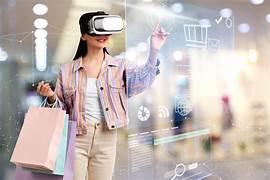
AR & VR in Retail: Creating Immersive Shopping Experiences.
AR (Augmented Reality) and VR (Virtual Reality) are transforming retail by creating immersive, interactive shopping experiences. These technologies allow customers to visualize products, explore virtual stores, and engage with brands in innovative ways, whether online or in physical spaces. As consumer expectations evolve, AR and VR offer retailers powerful tools to enhance personalization, reduce returns, and build deeper emotional connections with their audiences—shaping the future of modern.
✨ Raghav Jain

Introduction
The retail industry has undergone a dramatic transformation over the last decade. The integration of digital technologies has shifted consumer expectations, making personalized and immersive experiences a necessity rather than a luxury. Among these technologies, Augmented Reality (AR) and Virtual Reality (VR) stand out as the most promising tools for creating deeply engaging customer experiences.
AR overlays digital information on the real world using devices like smartphones, tablets, or AR glasses. VR, on the other hand, immerses users in a completely digital environment using headsets like Oculus Rift or HTC Vive. Together, AR and VR are not only enhancing the online and in-store retail experience but also shaping the future of consumer behavior and brand interaction.
The Evolution of AR & VR in Retail
AR and VR were initially perceived as futuristic concepts confined to gaming or niche tech. However, with increasing smartphone penetration, faster internet speeds, and more affordable headsets, retailers began experimenting with these technologies. Early adopters like IKEA, Sephora, and Nike have already showcased how AR & VR can transform customer engagement.
In 2016, IKEA released its AR app that allowed customers to visualize furniture in their home spaces before purchasing. Sephora's Virtual Artist lets users try on makeup virtually, while Nike has implemented AR to measure customers’ feet accurately for perfect shoe sizing. These innovations weren’t just tech novelties; they significantly boosted customer satisfaction and reduced return rates.
AR in Retail: Enhancing the Real World
1. Virtual Try-Ons
One of the most widely adopted uses of AR in retail is virtual try-ons. Customers can see how clothes, glasses, makeup, or even jewelry would look on them using their phone camera. Brands like Warby Parker and L'Oréal have significantly benefited from this technology by reducing product returns and improving the buying experience.
2. In-Store Navigation
Large retail stores can be confusing for customers. AR apps provide real-time navigation to help users find specific items, similar to a GPS system but inside the store. Lowe’s Vision app is a perfect example—it helps customers locate products on shelves through AR maps.
3. Product Information Overlay
AR allows shoppers to scan a product with their phone and receive detailed information such as price, ingredients, user reviews, or even video demonstrations. This layer of interactive content enhances transparency and builds trust.
4. Interactive Advertising
Retailers now use AR for interactive ads. For instance, a customer can scan a billboard or print ad to trigger 3D product animations or virtual tours. This bridges offline and online marketing seamlessly.
VR in Retail: Creating Virtual Worlds
1. Virtual Stores
VR allows brands to create entirely virtual showrooms. Retailers like Alibaba and eBay have already piloted virtual shopping malls where customers can browse and shop just like in physical stores—except from the comfort of their homes.
2. Immersive Product Experiences
Customers can explore products in a more engaging way. For example, car retailers like Audi use VR to let users experience different car models, interiors, and features without visiting a dealership.
3. VR for Staff Training
Retailers also use VR for internal purposes. Walmart has used VR to train employees on customer service, managing Black Friday sales, and store safety. It provides risk-free, realistic training environments that improve learning outcomes.
4. Emotional Branding
VR is also used to create emotional brand connections. TOMS Shoes created a VR experience that takes users to Peru to witness the impact of their "One for One" initiative. This humanized the brand and boosted consumer loyalty.
Benefits of AR & VR in Retail
- Improved Customer Engagement: Immersive experiences capture attention and enhance the time spent on a brand’s platform or store.
- Reduced Returns: Virtual try-ons and accurate visualization help customers make more informed choices, decreasing return rates.
- Personalized Shopping: AR & VR allow brands to tailor experiences based on user preferences, history, or location.
- Omnichannel Integration: These technologies merge offline and online retail, offering a cohesive and dynamic shopping journey.
- Competitive Advantage: Retailers adopting AR & VR stand out in a crowded market and position themselves as tech-savvy innovators.
Challenges in Adoption
Despite the benefits, several challenges hinder the widespread adoption of AR & VR in retail:
- High Initial Costs: Developing custom AR/VR applications or VR-enabled stores can be expensive.
- Technology Adoption: Not all customers have access to VR headsets or the latest smartphones.
- Content Development: Creating high-quality, engaging AR/VR content requires specialized skills and continuous updates.
- Data Privacy: Collecting customer data through these technologies raises concerns around consent, storage, and usage.
- ROI Measurement: Quantifying the return on investment for immersive experiences can be complex and may take time to manifest.
Real-World Examples of AR/VR in Retail
- IKEA Place App: Uses AR to allow users to place furniture in their homes virtually before buying.
- Sephora Virtual Artist: Enables customers to try makeup products via AR.
- Nike Fit: Utilizes AR to scan customer feet and suggest the perfect size.
- eBay VR Department Store (Australia): In collaboration with Myer, created a virtual store offering over 12,000 products.
- Lowe’s Holoroom: A VR experience that helps customers design and visualize their dream kitchens or bathrooms.
Future Trends of AR & VR in Retail
- Metaverse Integration: Retailers are exploring metaverse platforms to create persistent virtual stores accessible from anywhere.
- AI + AR/VR Synergy: Artificial Intelligence will enhance personalization in AR/VR experiences, making them more intuitive and adaptive.
- Haptic Feedback: Integration of tactile feedback in VR can make product exploration even more realistic.
- Wearable AR Glasses: With the rise of devices like Apple Vision Pro and Meta’s AR glasses, AR experiences may soon be more seamless and hands-free.
- Sustainability Use Cases: Virtual fashion shows or product previews reduce the need for physical samples, helping brands lower environmental impact.
Augmented Reality (AR) and Virtual Reality (VR) are revolutionizing the retail industry by creating immersive, engaging, and personalized shopping experiences that were once confined to science fiction. With increasing competition and evolving consumer expectations, retailers are turning to these technologies to differentiate their brands, improve customer satisfaction, and streamline operations both online and offline. AR enhances the physical world by overlaying digital information through smartphones or AR glasses, allowing consumers to interact with virtual elements in real-time, while VR immerses users in entirely simulated environments using specialized headsets, offering them the ability to explore virtual stores, products, and experiences from anywhere. The applications of AR in retail are vast and impactful, including virtual try-ons for fashion and cosmetics, in-store navigation systems, interactive packaging, and digital overlays that provide additional information, reviews, and even animations about products. For example, brands like Sephora and L'Oréal have pioneered AR makeup try-on tools that allow users to test different products virtually, while furniture companies like IKEA use AR to help customers place virtual furniture in their homes to assess size and fit. In physical retail environments, AR is also used to create engaging window displays and in-store experiences, such as scanning a product to reveal promotional content or gamified elements. Meanwhile, VR takes consumer engagement to another level by offering virtual showrooms, immersive product tours, and lifelike brand storytelling. Retail giants like Alibaba, eBay, and Tommy Hilfiger have introduced VR stores and fashion shows where customers can browse, interact, and shop in a 3D world from the comfort of their home. Car brands like Audi and BMW have adopted VR to showcase different car configurations and features, giving buyers an in-depth and emotional connection with the product before visiting a dealership. Beyond customer interaction, VR is increasingly being used for staff training in retail chains such as Walmart and Lowe’s, allowing employees to simulate customer service scenarios, holiday rushes, or even crisis management exercises in a controlled, realistic setting. These technologies provide tangible business benefits such as higher conversion rates, fewer returns (as customers make more informed decisions), better brand engagement, and improved operational efficiency. Furthermore, AR and VR support sustainability goals by reducing the need for physical samples, printed materials, and excessive packaging. Despite their benefits, AR and VR adoption in retail is not without challenges. High initial investment, the need for technical expertise, limited consumer access to devices (particularly VR headsets), privacy concerns around data collection, and difficulties in measuring ROI remain barriers for many retailers. However, the landscape is shifting as costs decrease and customer familiarity with immersive technologies increases. Technological advancements are also driving more widespread adoption; for example, the integration of Artificial Intelligence with AR/VR platforms enables hyper-personalized experiences that learn from customer behavior and adapt in real time. Moreover, the advent of AR glasses, haptic feedback tools, and 5G connectivity is making these technologies more accessible and effective. Looking forward, AR and VR are expected to play a central role in the rise of the metaverse—a digital universe where consumers will be able to shop, socialize, and engage with brands in fully immersive environments. Retailers are already experimenting with persistent virtual storefronts and branded experiences inside platforms like Decentraland and Roblox. The convergence of physical and digital shopping through AR and VR is shaping a new era of "phygital" retail—an ecosystem where customer journeys seamlessly bridge both real and virtual worlds. In this paradigm, a consumer might try on clothes using AR at home, get measured with AI-assisted tools, and then complete the purchase in a virtual store using VR—all within a single, interconnected experience. Companies investing early in these technologies are not only gaining a competitive edge but are also shaping the expectations and behaviors of the next generation of shoppers. From AR-powered cosmetic trials and virtual car test drives to VR staff onboarding and metaverse shopping malls, the impact of immersive technologies on retail is profound and accelerating. The fusion of experience and convenience that AR and VR provide is redefining how people shop, how brands tell their stories, and how retail operates on every level—from supply chain to storefront. As consumer interest continues to grow, and as the tools become more cost-effective and widespread, AR and VR are set to become foundational elements of retail strategy, not just experimental add-ons. In conclusion, the retail sector stands on the cusp of a technological transformation driven by AR and VR innovations that enrich customer engagement, improve personalization, and provide a competitive edge in a crowded marketplace. While there are challenges to overcome, including cost and accessibility, the benefits are becoming too significant to ignore. Retailers who embrace these immersive tools will not only enhance their current offerings but also future-proof their businesses for the coming digital evolution of commerce.
The rapid evolution of Augmented Reality (AR) and Virtual Reality (VR) is reshaping the retail industry by introducing immersive, interactive, and highly personalized shopping experiences that redefine how consumers engage with brands and make purchasing decisions. AR overlays digital elements onto the physical world, often via smartphones, tablets, or wearable devices like AR glasses, allowing users to visualize how products will look or function in real life before committing to a purchase, while VR creates entirely digital environments where customers can simulate store visits, product interactions, or even entire brand journeys using specialized headsets. This transformation is driven by changing consumer expectations for more engaging and convenient shopping experiences, increased digital connectivity, and technological advancements that make immersive experiences more accessible and scalable for businesses of all sizes. Retailers across sectors—fashion, cosmetics, furniture, automotive, and more—are leveraging these technologies to bridge the gap between physical and digital commerce. For instance, in the fashion and beauty industries, AR-powered virtual try-ons allow shoppers to preview how clothes, makeup, or accessories will look on them in real time, using nothing more than a mobile device camera. Brands like Sephora, L’Oréal, and Warby Parker have implemented virtual mirrors or face-mapping tools that let users experiment with different products from home, leading to higher engagement, fewer returns, and greater customer satisfaction. In the furniture sector, IKEA’s AR app enables customers to position true-to-scale 3D models of furniture in their homes, testing different layouts, colors, and designs to ensure compatibility with existing décor—dramatically improving buyer confidence. On the other hand, VR brings shoppers into entirely fabricated environments, allowing retailers to create virtual stores, fashion runways, car showrooms, or even immersive storytelling experiences that highlight brand values, origin stories, or charitable missions. Companies like Alibaba and eBay have introduced virtual shopping malls where customers can browse products as if they were physically present, with navigation, interaction, and checkout processes streamlined for VR. Automotive giants such as Audi and BMW have used VR to provide digital test drives or model explorations, saving customers the need for in-person visits. Beyond consumer applications, VR also serves internal retail functions like staff training—Walmart, for example, utilizes VR to prepare employees for high-pressure sales events like Black Friday, simulating crowd management, inventory challenges, and customer service interactions in a controlled environment that improves performance and reduces training time. The business benefits of adopting AR and VR in retail are manifold, including increased conversion rates due to better-informed purchase decisions, reduced product returns as customers can virtually assess items beforehand, enhanced customer engagement through gamified or interactive experiences, and strengthened brand loyalty as immersive environments foster deeper emotional connections. Moreover, these technologies support omnichannel strategies by blending digital and physical touchpoints into seamless, personalized experiences across platforms—whether online, in-store, or in emerging virtual environments like the metaverse. Despite these advantages, challenges remain. Developing and maintaining high-quality AR and VR experiences requires significant investment in hardware, software, and content creation, which can be a barrier for smaller retailers. Not all consumers have access to VR headsets, and even AR features may require newer smartphones or apps, limiting the reach of campaigns. Data privacy is another concern, as these technologies often rely on facial recognition, location tracking, or behavioral data to personalize experiences, necessitating clear consent mechanisms and secure data handling. Furthermore, measuring the return on investment for AR/VR initiatives can be complex, as traditional metrics may not fully capture the long-term brand equity and consumer perception benefits. Nonetheless, the future of AR and VR in retail looks promising, with trends indicating broader adoption and deeper integration across the shopping journey. The convergence of AI with AR/VR is leading to hyper-personalized experiences where systems can recommend products, adapt environments, or modify experiences in real time based on user preferences and behaviors. Haptic feedback technologies are emerging to give users tactile sensations within VR environments, enhancing realism. Wearable AR devices such as smart glasses are expected to become more common, providing hands-free, always-on access to digital enhancements while shopping. Additionally, retailers are exploring the potential of immersive commerce in the metaverse—a persistent, shared digital space where virtual storefronts, branded games, NFT-based products, and avatar-based social shopping will become standard practice. Major brands like Nike, Gucci, and Adidas are already establishing their presence in these digital worlds, using AR and VR to engage younger, tech-savvy consumers who value experience as much as product. Sustainability is another dimension where AR/VR plays a crucial role—by reducing the need for physical samples, printed catalogs, or unnecessary product transportation, retailers can lower their environmental footprint. Virtual fashion shows, 3D product demos, and interactive catalogs all serve to communicate product value without generating waste. The growing integration of AR and VR into mainstream retail also indicates a shift from these technologies being “nice-to-have” innovations to essential tools for maintaining competitive advantage in an increasingly digital, experience-driven economy. In conclusion, AR and VR are not merely futuristic fantasies but present-day realities that are redefining the contours of retail by enhancing personalization, streamlining operations, and creating captivating customer experiences. While cost, accessibility, and data concerns present short-term hurdles, the long-term value of immersive technologies is undeniable, offering retailers the opportunity to not just keep pace with change but to lead it. Businesses that strategically implement AR and VR now will be better equipped to meet the expectations of tomorrow’s consumer and thrive in the evolving landscape of global commerce.
Conclusion
AR and VR technologies are fundamentally reshaping the retail landscape by offering immersive, personalized, and engaging shopping experiences. From AR-enabled makeup try-ons to VR-powered virtual showrooms, these tools are enhancing customer satisfaction and operational efficiency. While there are hurdles—such as cost, accessibility, and privacy—advancements in tech and growing consumer openness to immersive experiences are steadily overcoming them.
The integration of AR and VR is no longer a novelty but a strategic imperative for forward-looking retailers. As these technologies become more affordable and widespread, they will become central to how brands attract, engage, and retain customers in both digital and physical spaces.
Q&A Section
Q1:- What is the difference between AR and VR in retail?
Ans:- AR enhances the real-world environment by overlaying digital information using devices like smartphones or AR glasses, while VR immerses the user in a completely virtual world through headsets, creating a simulated shopping environment.
Q2:- How does AR improve online shopping experiences?
Ans:- AR allows customers to virtually try on products (e.g., clothing, makeup, furniture), visualize how items fit into their lives, and make more confident purchase decisions, reducing return rates and increasing satisfaction.
Q3:- What are the most common applications of VR in retail?
Ans:- VR is commonly used for virtual stores, immersive product demos (like test-driving a car), emotional brand storytelling, and employee training simulations.
Q4:- Which companies are leading in AR/VR retail innovations?
Ans:- Brands like IKEA, Nike, Sephora, Lowe’s, Walmart, and Alibaba are among the leaders in implementing AR and VR technologies to enhance the shopping experience.
Q5:- Are there any challenges in adopting AR/VR in retail?
Ans:- Yes, challenges include high development costs, limited consumer access to VR devices, content creation complexity, data privacy concerns, and difficulties in measuring ROI.
Similar Articles
Find more relatable content in similar Articles

From Classroom to Career: App..
Skill-building apps help stud.. Read More

Smart Study to Smart Career: ..
Smart study and career apps a.. Read More

Top Educational Apps That Boos..
Educational apps are transfor.. Read More

The Future of Social Media Ma..
AI is transforming social med.. Read More
Explore Other Categories
Explore many different categories of articles ranging from Gadgets to Security
Smart Devices, Gear & Innovations
Discover in-depth reviews, hands-on experiences, and expert insights on the newest gadgets—from smartphones to smartwatches, headphones, wearables, and everything in between. Stay ahead with the latest in tech gear
Apps That Power Your World
Explore essential mobile and desktop applications across all platforms. From productivity boosters to creative tools, we cover updates, recommendations, and how-tos to make your digital life easier and more efficient.
Tomorrow's Technology, Today's Insights
Dive into the world of emerging technologies, AI breakthroughs, space tech, robotics, and innovations shaping the future. Stay informed on what's next in the evolution of science and technology.
Protecting You in a Digital Age
Learn how to secure your data, protect your privacy, and understand the latest in online threats. We break down complex cybersecurity topics into practical advice for everyday users and professionals alike.
© 2025 Copyrights by rTechnology. All Rights Reserved.